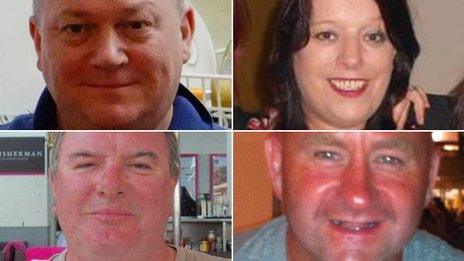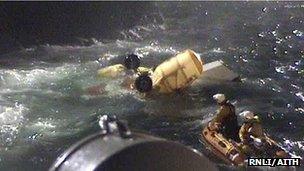Shetland helicopter crash: Investigators search for black box
- Published

Four people died in the incident. Clockwise from top left: George Allison, 57, Sarah Darnley, 45, Duncan Munro, 46, Gary McCrossan, 59
Experts are using specialist sonar equipment to locate a key piece of evidence in the investigation into the Super Puma crash off Shetland.
Four people died when the helicopter carrying oil workers crash landed into the North Sea on Friday.
The fuselage was recovered on Sunday but the salvage team is still looking for the tail section, which contained the black box flight data recorder.
Industry representatives have agreed all Super Pumas should remain grounded.
Meanwhile, the fourth body has arrived in Aberdeen, after an overnight ferry sailing.
The RMT union has said it will hold a rally in Aberdeen on Wednesday morning to highlight offshore safety concerns.
At a meeting of key offshore operators and contractors on Monday, contingency plans were discussed.

RNLI volunteers inspect the helicopter wreckage
Helicopter operators are set to share aircraft and workers will also be transferred on and offshore by boat.
Oil giant Total has confirmed it has chartered four vessels to take workers to and from its platforms.
And BP is bringing in extra Sikorsky aircraft.
Both firms are considering scaling back non-essential work offshore.
The crash on Friday killed three men and a woman.
They were Duncan Munro, 46, from Bishop Auckland, Sarah Darnley, 45, from Elgin, Gary McCrossan, 59, from Inverness, and George Allison, 57, from Winchester.
They were among 18 people on board the Super Puma AS332 L2 as it flew from the Borgsten Dolphin rig to Sumburgh Airport in Shetland.
'Level of grief'
Two of the 14 people rescued remain in hospital.
It is hoped the information contained in the flight data recorder will help establish what caused the aircraft to suffer a catastrophic loss of power on approach to Sumburgh airport.
The salvage vessel Bibby Polaris remains at the crash site.
Oil and Gas UK Chief Executive, Malcolm Webb, said a number of options were being considered to transport workers while the Super Pumas are out of service
Speaking after the meeting in Aberdeen, Oil and Gas UK Chief Executive, Malcolm Webb, said a number of options were being considered to transport workers while the Super Pumas are out of service.
He added: "We will look at several things. We will look at sharing of aircraft, what can we do to make sure the capacity that is available to us is used as efficiently as we possibly can.
"We will look to see if there are any other aircraft around the world that could be brought in to the UK to assist and we will also look at marine transfers."
Duncan Trapp of CHC Helicopter, which operated the Super Puma, has promised the crash will be "painstakingly investigated".
He said: "We are fully supporting the early stages of the investigation into the incident and will continue to give our full co-operation to this process."
RMT general secretary Bob Crow said: "No-one should underestimate the level of grief and anger felt amongst the offshore workforce in light of Friday night's disaster.
"Twenty-five years after Piper Alpha the industry is today confronted by another series of basic demands and assurances on worker safety."
Balpa, the union which represents professional pilots, said in a statement: "The confidence of members in the Super Puma family of aircraft remains unchanged.
"We should not rush to judge an aircraft which has three very different variants and has successfully transported millions of passengers worldwide in safety over 30 years of operation."

CHC, which operated the crashed Super Puma, has promised a "painstaking" investigation into the crash
The Super Puma AS 332 can carry two crew and up to 19 passengers. The one which crashed was operated by CHC, one of three helicopter companies serving the oil and gas industry in the North Sea.
Super Pumas account for about 70% of helicopters operating in the North Sea. There are several types - CHC has nine AS 332 L2s, one L1 and four EC 225 Super Pumas in the North Sea
Super Pumas are made by the Franco/German/Spanish Eurocopter group, which has 11,780 helicopters in service in 148 countries
In total there are about 57,000 people working offshore in the North Sea across nearly 600 facilities, served by about 100 helicopter flights per day, or about 45,000 per year.
Source: CHC, Eurocopter
- Published27 August 2013
- Published26 August 2013
- Published25 August 2013
- Published25 August 2013
- Published24 August 2013